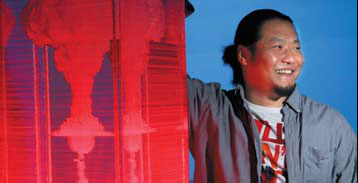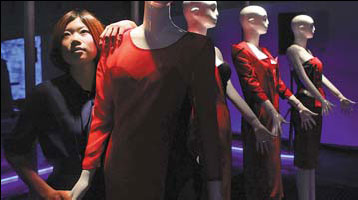Life and Leisure
Designers shed light on innovation
By Sun li (China Daily)
Updated: 2010-10-12 08:02
 |
Large Medium Small |
|
Conceptual artist Li Hui with his work Transition. Photos by Zou Hong / China Daily |
|
Fashion designer Vega Wang with her couture project Into the Deep. |
When The Creators Project, an initiative by VICE Media Group and Intel to identify creative works from around the world, hit Beijing last month, two Chinese artists outshone the others by using light to push aesthetic boundaries.
Li Hui, a 33-year-old conceptual artist based in Beijing's Songzhuang Art Zone, impressed thousands of viewers with his manipulation of laser beams in his work titled Transition.
It features a real wrecked Jeep Cherokee illuminated by 13,000 flaming lasers placed on the ceiling above. The heat generated by the lasers causes vapors to rise from the cloth covering the vehicle, giving the design a fantastic misty look in the pitch-dark exhibition space.
According to the artist, the wrecked car represents injury and death, while the laser-generated fog effect echoes the title, representing a transition from the dead body to the living soul.
"High-tech materials like laser beams can evoke emotions and help articulate exciting and metaphysical ideas," Li says. "Laser is special in that it looks tangible while in reality it is not. That makes it a perfect medium for me because I like to give my works a visible yet verbally inexpressible touch."
A graduate of the Central Academy of Fine Arts, Li has always sought to use technology for artistic innovation. His passion for lasers helped him jump-start his career when he was invited to display some works that showcased his experiments with lasers at the Light Art Museum, Eindhoven, the Netherlands, in July.
The work that won much acclaim featured two optical cages that appeared alternatively. A group of viewers who found themselves blockaded in the cage at one moment would suddenly find themselves outside the cage in the next. Li says it captures the idea of a subtle contrast between reality and illusion.
"Technology is good for art because it widens an artist's choices and enriches the vocabulary of art," he says. "But technology is not for showing off, I use it only to support my art."
Vega Wang, 25, a graduate of the Central Saint Martins College of Art and Design in London stunned audiences with her maiden design - an exquisite white garment that shimmered in the dim display hall.
Titled Into the Deep, the couture project highlighted Elumin8 (otherwise known as Electroluminescent Light), a cool, soft light which Wang embedded in the inside of the fabric.
Growing up in an environment where both parents were electrical engineers, Wang has always experimented with wires and plugs.
When pondering her first art work combining art and technology, it was only natural for her to incorporate the skills she picked up in her childhood.
But it was a BBC documentary, Deep Blue, that really inspired her design.
She was amazed to see that the deep sea creatures featured in that documentary, like the ray fish and jellyfish, produce light and this led her to research the science of bioluminescence, or light emission in biological organisms.
"Those creatures were so magical that I wanted to create something to honor them," Wang says. "I also hope that my design can remind people about these endangered species of the sea."
The designs were animated, to resemble the motion of these majestic light-emitting fishes. And the designer's ecological perspective was reflected in her choice of material, Elumin8.
Compared to the more frequently used LED (light-emitting diode), Elumin8 is thinner, more flexible and more efficient.
Wang has been running her own studio at Jianwai SOHO in Beijing for a year, and is now working on innovative fabrics.
"Applying technology to new fabrics is very important in fashion design, as fabrics can determine a garment's silhouette," she says.
"In today's technologically oriented society, a fashion designer had better be tech-savvy."
China Daily

